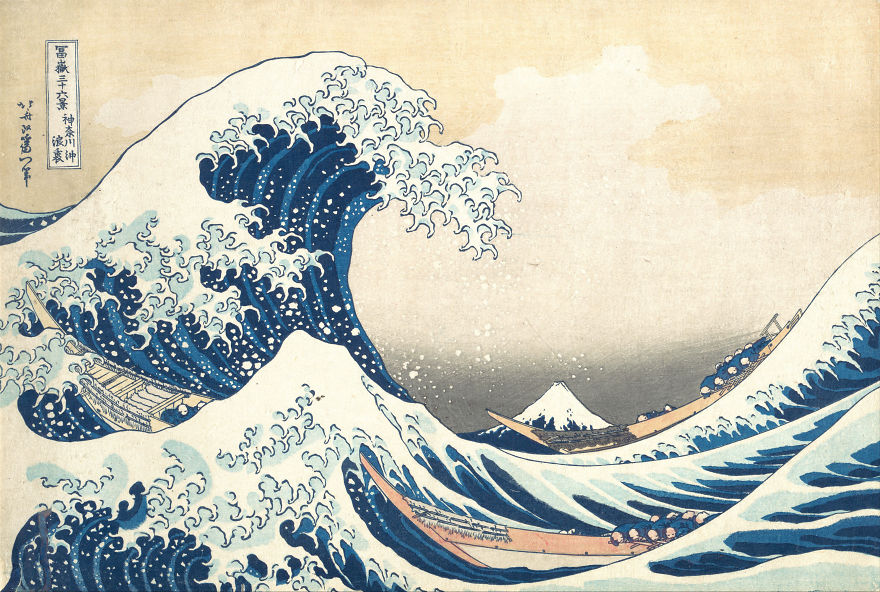
Katsushika Hokusai’s “The Great Wave off Kanagawa” is a masterpiece of Japanese ukiyo-e art and one of the most recognizable images in the history of art. Part of Hokusai’s celebrated series Thirty-Six Views of Mount Fuji, this iconic woodblock print captures a dramatic moment in nature—a monstrous, curling wave about to crash down upon three small fishing boats off the coast of Kanagawa Prefecture in Japan. In the background, seemingly untouched by the chaos in the foreground, Mount Fuji rises with stoic calmness. Though small in scale within the composition, it exudes stability and permanence.
The power of the print lies not just in its technical excellence, but in the narrative it tells through imagery. At first glance, it may appear to be a simple depiction of a turbulent sea, yet with closer examination, the depth of symbolism and artistic intention becomes evident. The massive wave dominates the scene, towering over the humans below, whose frail vessels underscore their vulnerability against nature’s force. The wave’s crest forms claw-like fingers that seem to reach menacingly downward, echoing the threat of annihilation. Meanwhile, Mount Fuji—the sacred symbol of eternity and national identity in Japan—sits serene and immovable in the distance. This interplay between chaos and calm, fragility and permanence, is at the heart of the print’s enduring emotional and philosophical appeal.
A key to understanding “The Great Wave” is recognizing Hokusai’s fusion of Japanese tradition with Western influences. The perspective employed in this piece reflects an understanding of European linear perspective, a technique not commonly seen in traditional Japanese art prior to Hokusai’s era. The boats, waves, and mountain are arranged with a realism and spatial depth influenced by European prints that had begun to trickle into Japan during the Edo period. Moreover, the use of Prussian blue—a synthetic pigment imported from Europe—marked a technical innovation. This bold, vivid blue not only added vibrancy and contrast to the piece but also demonstrated Hokusai’s willingness to experiment with new materials and visual languages.
Despite being over 190 years old, “The Great Wave” resonates with contemporary audiences in profound ways. It touches on themes of natural disaster, human struggle, and the awe-inspiring might of the sea, which are universally understood across cultures and time periods. At the same time, it encapsulates a very Japanese philosophical outlook: the transience of life, captured in the concept of mono no aware, or “an awareness of the impermanence of things.” The wave is a moment frozen in time, the split second before impact, reflecting the fleeting nature of existence. The composition arrests this ephemerality in a lasting form, and it is this emotional duality—both terror and beauty—that keeps viewers captivated.
Hokusai was seventy years old when he created this masterpiece, a period he referred to as the beginning of his “true” artistic maturity. In fact, he believed his skills would only truly peak when he reached the age of one hundred. This deep dedication to his craft is evident in every line of the print. The clarity of the drawing, the economy of shape, and the fluidity of movement within the composition suggest a lifetime of mastery. There is balance and tension in equal measure. The negative space of the sky enhances the looming presence of the wave, while the diagonal lines of the boats slice through the horizontal composition, amplifying the sense of urgency.
Beyond its aesthetic mastery, “The Great Wave” is culturally significant in both Japanese and global contexts. It became one of the most famous images associated with Japonisme, the craze for Japanese art and design that swept through Europe in the late 19th century. Artists such as Claude Monet, Edgar Degas, and Vincent van Gogh collected and were deeply influenced by ukiyo-e prints. The graphic clarity and flattened planes of color found in Hokusai’s works offered an alternative to the European tradition of realism and academic painting. They helped inspire the rise of Impressionism and Post-Impressionism, two movements that reshaped Western art.
The print’s visual language—its stylized forms, its framing of nature, its expressive dynamism—has had a lasting impact that reaches far beyond the 19th century. In modern times, it has been reproduced on everything from posters and T-shirts to album covers and internet memes. It appears in animated films, corporate logos, and even emojis. And while this ubiquity risks reducing the image to a pop-culture icon, its deeper resonance has not diminished. In fact, the repetition of its imagery across media might be seen as a continuation of Hokusai’s own ethos: to make art accessible to everyone. Ukiyo-e prints were designed for mass production, and Hokusai’s work was meant not for aristocrats but for ordinary townspeople. The print’s global visibility today could be viewed as an extension of that democratizing spirit.
The philosophical dimensions of the artwork also contribute to its staying power. The confrontation between man and nature, between transience and permanence, evokes age-old human concerns. Are we insignificant before nature? Can we find peace amid chaos? These questions remain as relevant today as they were in Hokusai’s time, especially in an era marked by climate change and environmental uncertainty. The wave, therefore, becomes a symbol not just of physical threat, but of existential reflection. It is a meditation on the sublime—the aesthetic concept describing beauty that inspires both awe and fear. This duality is perfectly embodied in the immense wave that is both majestic and terrifying.
Another fascinating aspect of the print is the multiplicity of perspectives it offers. On one level, it’s a marine scene; on another, it’s a metaphor for life’s unpredictability. Viewers may interpret the boats as a symbol of the human journey, tossed about by fate. Others might see the wave as a metaphor for a personal crisis or an emotional surge. The print accommodates all these readings without ever feeling didactic. It invites reflection rather than dictating interpretation. This openness is one of its greatest strengths, allowing it to be constantly reinterpreted and recontextualized.
Moreover, “The Great Wave” stands as a testament to the enduring relevance of printmaking as a fine art form. In an age dominated by digital screens and mass media, the craftsmanship behind Hokusai’s work reminds us of the tactile and technical dimensions of art. Creating a woodblock print required collaboration between the artist, the carver, and the printer. The process was meticulous, involving multiple blocks for different colors, perfect alignment, and deep knowledge of materials. The fact that this image could be reproduced hundreds of times speaks to the skill involved in every stage of production.
For all its sophistication, there is a certain humility to the work as well. It does not glorify humanity’s dominance over nature; rather, it shows humans in harmony with the forces that threaten them. The fishermen do not appear panicked; they are focused, resigned, possibly even at peace. This subtle expression suggests a worldview grounded in acceptance, not struggle. It echoes the teachings of Buddhism and Shintoism, which emphasize the importance of living in balance with the natural world and recognizing the impermanence of all things.
In the nearly two centuries since it was first published, “The Great Wave off Kanagawa” has achieved a status few artworks enjoy. It is instantly recognizable, endlessly referenced, and universally admired. And yet, despite this familiarity, it continues to reveal new insights to those who engage with it thoughtfully. Whether viewed as a masterpiece of composition, a cultural touchstone, or a philosophical allegory, it never ceases to impress with its grace and power.
To truly appreciate the piece is to understand the artist behind it. Katsushika Hokusai was a man of relentless creativity. Over his long career, he produced more than 30,000 works, ranging from paintings and prints to book illustrations and sketches. He changed his name over 30 times, reflecting shifts in his artistic identity. Despite his fame, he lived modestly and died in near-poverty. Yet his legacy is enormous, not just in terms of influence, but in the way he bridged cultures, genres, and epochs through his art.
Today, original impressions of “The Great Wave” can be found in major institutions around the world, including the British Museum in London, the Metropolitan Museum of Art in New York, and the Tokyo National Museum. Each print offers subtle variations due to the nature of hand-printing, adding to their uniqueness and allure. Collectors and historians continue to study them, revealing insights into paper types, pigment composition, and the economics of the Edo-period print market.
Ultimately, “The Great Wave off Kanagawa” stands as an enduring symbol of both artistic excellence and human contemplation. It transcends time and geography, speaking to viewers across cultures and generations. It serves as a reminder that great art does not just mirror the world—it helps us understand our place within it. The image of the wave, frozen at the height of its power, becomes a mirror of our own lives: momentary, fragile, but beautiful in their intensity.

